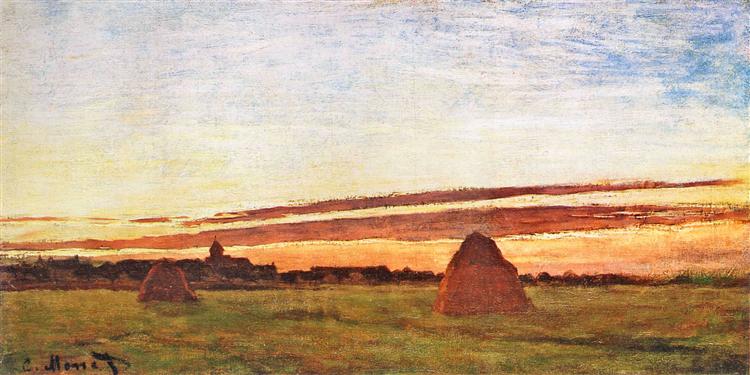Description
Claude Monet's Haystacks at Chailly, painted in 1865, encapsulates not only the haunting beauty of the French rural landscape, but also the evolution of Impressionist art, with which Monet became a pioneer. This painting is part of a series that reflects his fascination with the effects of light and atmosphere on everyday scenes, in this case, the haystacks that were an ingrained feature of the agricultural setting of Chailly, a small village in the Normandy region.
Examining the composition of the work, we find a landscape dominated by an astonishing use of perspective and the arrangement of elements. In the foreground, the large, voluminous forms of hay stand out, seeming to overflow from the canvas, providing a sense of three-dimensionality. Monet has used a loose, rapid brushstroke that emphasizes the texture of the hay, generating a visual dialogue between matter and light. The slope of the field and the horizon line suggest a continuity that invites the viewer to lose themselves in the pastoral scene.
Color is central to this work and to Monet's work in general. The palette used in "Haystacks at Chailly" displays a rich array of golden and yellow hues that intertwine with deep greens and brown undertones, creating a warm and inviting atmosphere. These colors not only portray a tangible reality, but also evoke an emotional atmosphere. Monet strives to capture the changing light of the day while playing with the perception of space: the vibrant hues seem to capture the exact moment when light bathes the landscape, showing the transition between light and shadow.
Unlike other works of the period, such as those depicting the human figure, in Haystacks at Chailly there are no visible figures; the focus is entirely on the landscape. However, the absence of human figures does not take away from the life of the work. On the contrary, their implicit presence in the agricultural setting transforms the painting into a testimony of rural life, work and the connection between human beings and the land. This approach also underlines Monet's tendency to seek the essence of what he observes, sometimes leaving behind figurative narrative to study variations in light and colour.
Monet, as part of the Impressionist movement, was on the cusp of an artistic revolution that would challenge the established conventions of the academy. The series of haystacks he painted at different points in his career, such as "The Haystacks at Giverny", share this meticulous exploration of light and shadow. "Haystacks at Chailly" is, in this sense, a significant step that demonstrates his interest in the landscape as a living, breathing space, where light is the protagonist.
Ultimately, the work can be seen as a reflection on the permanence and impermanence of life. As the light changes, so does the landscape; this link is an echo of the cycle of existence itself, a theme that would resonate throughout Monet’s later work. Haystacks at Chailly is more than a portrait of a landscape: it is a meditation on the moment, life, and the ephemeral beauty that reveals itself to the observer willing to look beyond the surface.
KUADROS ©, a famous painting on your wall.
Hand-made oil painting reproductions, with the quality of professional artists and the distinctive seal of KUADROS ©.
Painting reproduction service with satisfaction guarantee. If you are not completely satisfied with the replica of your painting, we will refund 100% of your money.

